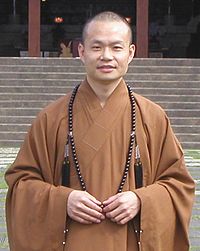Buddhist monasticism
[2] According to Buddhist tradition, the order of monks and nuns was founded by Gautama Buddha during his lifetime between the fifth and fourth centuries BCE when he accepted a group of fellow renunciants as his followers.
[3][2] Out of this tradition grew two kinds of living arrangements for monastics, as detailed in the Mahavagga section of the Vinaya and Varsavastu texts: One of the more famous Arama is Anathapindika's, known as Anathapindikassa arame, built on Prince Jeta's grove.
Textual and archaeological evidence point to the existence of numerous monasteries in the area around Rajagriha, and the eventual development of large monastic universities in northern India that housed thousands of resident monks.
[3] They were eventually replaced by traditions of women ordained as novices, such as the mae ji of Thailand and Dasa sil matavas of Sri Lanka.
In return for the support of the laity, monks and nuns are expected to live an austere life focused on the study of Buddhist doctrine, the practice of meditation, and the observance of good moral character.
Ordination in the bhikkhuni lineage continues to exist among East Asian communities, and attempts have been made at a revival in Southeast Asia and Sri Lanka.
[3] Women in Theravada countries have also faced official and popular resistance to the re-establishment of fully ordained bhikkhuni lineages.
[3] Women monastics follow a similar progression, but are required to live as Samaneras for a longer period of time, typically five years.
[citation needed] Higher ordination must take place before a quorum of monastics, with five being an allowable minimum, and ten suggested for ordinary circumstances.
[1] Those who have undergone higher ordination are required to follow a large number of additional rules, known as the Pratimokṣa, that govern their behavior, dress, and decorum.
[3] In Burma, Taiwan and Hong Kong, there is sometimes short term monastic ordination available to lay Buddhists to take some vows for a week up to month.
While most career monastics in the Theravada tradition undertake formal upasampada ordination as soon as they are eligible, monks in East Asia often remain novices.
[3] This may be due to a historical shortage of fully qualified temples able to provide upasampada ordination in East Asian communities.
[1] The disciplinary regulations for monks and nuns are intended to create a life that is simple and focused, rather than one of deprivation or severe asceticism.
Individual relationships of teacher/student, senior/junior, and preceptor/trainee may be observed among groups of monastics, but there are no formal positions, nor is there any authority to give orders or commands invested in senior monks.
An abbess or abbot, typically a senior monastic still young enough to be active, is usually responsible for the day-to-day administration of the monastery, and may appoint others to assist with the work.
[3] In East Asia, Confucian views discouraged begging and lead to many monasteries growing their own food and employing monks as cooks.
[14] Gelug school emphasized Vinaya ethics and monastic discipline; Choekyi Gyaltsen refused to wear monk clothing after he married.
This idea is said to be introduced by Saichō, the founder of the Tendai school, who preferred ordaining monks under the Bodhisattva vows rather than the traditional Vinaya.
[39] In Sri Lanka, Thailand, Cambodia, Laos, and Myanmar, where the Theravada school is dominant, there is a long tradition of temporary ordination.
During a school break, many young men usually ordain for a week or two to earn merit for loved ones and to gain knowledge of Buddhist teachings.
In most countries, this temporary ordination occurs during the vassa retreat, which is regarded as a period of intensified spiritual effort by local Buddhists.





